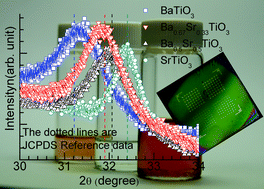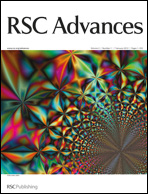We describe an optimized chemical synthesis route to obtain BaxSr1−xTiO3 (x = 0, 0.50, 0.67, 1.0) thin films with impeccable stoichiometry control. The molar ratios of the precursors were altered to produce the cubic phase of SrTiO3, Ba0.5Sr0.5TiO3, Ba0.67Sr0.33TiO3 and the tetragonal phase of BaTiO3 thin films on single crystalline p-Si (100) and quartz substrates. The obtained Raman spectra for the BaxSr1−xTiO3 thin films on quartz substrates showed characteristic vibration modes at ∼303, 515 and 716 cm−1. The active modes of BaTiO3 signify the tetragonal phase, which is important for its various technological advantages. The significant features of these materials were obtained through capacitance–voltage (C–V) measurements with Pt (or Ag)/BaxSr1−xTiO3/p-Si/Pt (or Ag) assemblies, at 1, 10 and 100 kHz. Substantial hysteresis (ΔV) of 315 mV (with Ag) and 219 mV (with Pt) was observed for Ba0.5Sr0.5TiO3, whereas for BaTiO3 and SrTiO3 the obtained hysteresis was 256 mV and 96 mV, respectively. The largest hysteresis of 793 mV was observed for SrTiO3 with a Pt electrode. The above findings are important for assessing the device compatibility of cost efficient solution processed BaxSr1−xTiO3 thin films.

You have access to this article
 Please wait while we load your content...
Something went wrong. Try again?
Please wait while we load your content...
Something went wrong. Try again?


 Please wait while we load your content...
Please wait while we load your content...